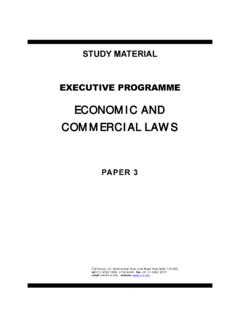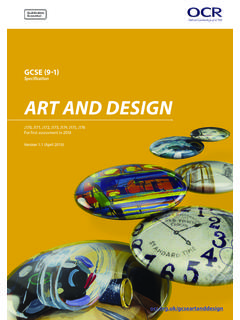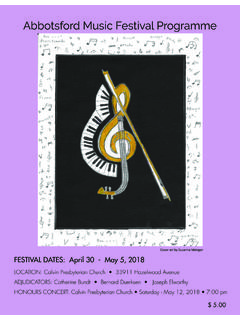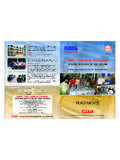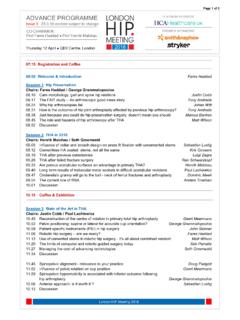Transcription of Abstract - Carole Gray
1 This paper attempts to put into context the development ofresearch methodology in the Crafts. It considers the formalrequirements for research by higher degrees, and defines theterm 'practice-led'. It observes that there appears to be a lack ofcritical contemporary debate in the Crafts. It is proposed thatresearch can be an important factor in the development ofdefining and elaborating this critical context. Conversely thislack of critical context could be seen to hamper research in thediscipline. The paper then reviews the current state ofcompleted formal research,* revealing a predominance ofhistorical, theoretical, and educational research practice-led research projects are then described: onecompleted and two ongoing research programmes(all in ceramics), and a further example drawn fromprofessional practice (jewellery). These examples are describedin terms of general methodological approach then expanded byspecific methods.
2 The paper concludes by proposing genericmethodological guidelines for future research in the Crafts, sothat learning, personal practice and the development of acritical context for the Crafts may benefit from the adoptionand promotion of 'accessible disciplined inquiry'. Malins & Gray, 1995 1 Appropriate Research Methodologies forArtists, Designers & Craftspersons: Research as a Learning Process AbstractAppropriate Research Methodologies for Artists, Designers & Craftspersons: Research as a Learning Processin collaboration withJulian Malins and Carole GrayKatie Bunnell & Eleanor WheelerThe Centre for Research in Art & Design,Gray's School of Art, Faculty of Design,The Robert Gordon University, Aberdeen,Scotland, : 01224 263639 fax: 01224 263636* Allison, B.,'Allison Research Index of Art &Design', Leicester:Leicester Expertise, 1992 This paper examines some recent developments inmethodological approaches to research in the Visual Arts.
3 Dueto the relative infancy of formal research in these disciplines, weare proposing that, at the moment, research methodology beconsidered as generic, applying to Fine Art, Design, and theCrafts. In due time these disciplines may well evolve particularand distinctive methodologies of their own. However, untilstrong discipline-specific strategies have emerged and beenvalidated, all can benefit from sharing approaches andexperiences. In this sense the research process is also a paper draws on ideas in three previously published papersby researchers at CRiAD, and assumes that further reference tothese would be made by the reader for philosophical andcontextual issues relating to methodology, 1, 2 and specificinformation relating to the structure and content of a proposedresearch methods course for artists and designers 3. Thereforewe have omitted in this paper to describe research projects inFine Art and Design areas (refer to cited papers), preferring tofocus on those which are research topics and methodologies described in this papershould mainly be considered in relation to the framework offormal study for higher degrees ( , ).
4 The canbe considered as a training to enable 'real' research to be carriedout at postdoctoral level; adopting this view means that theresearcher must acknowledge a certain humility for learning totake place. The structure requires a high level of rigour,transparency and some transferability. These characteristics arenot normally highlighted as part of day-to-day Craft practice,although many Craftpersons recognised the need forsystematic inquiry and a degree of 'methodologicaltransparency'.It may be helpful to state the criteria required for higher degreeawards. For the degree of a critical evaluation of thefield of inquiry and a understanding and application ofappropriate research methodologies for its investigation isdemanded. For the degree of , in addition to therequirements for , the researcher must have made anoriginal and independent contribution to knowledge *.
5 Eachdiscipline must interpret and apply these criteria to specificresearch projects, the choice of appropriate methodologiesbeing the most difficult to identify. The methodologiesdescribed in this paper have aimed to fulfil these Malins & Gray, 19951 'Research Procedure /Methodology for Artists &Designers, in:'Principles & Definitions: FivePapers by the EuropeanPostgraduate Art & DesignGroup', Winchester School ofArt, 19932 Artistic Research Procedure:Research at the Edge of Chaos?','Design Interfaces' ConferenceProceedings (refereed), Vol. 3,University of Salford, 19953 'Developing a ResearchProcedures Programme forArtists & Designers', CRiAD,The Robert Gordon University,1995*'How to Get a : AHandbook for Students andSupervisors',Phillips, M. and Pugh, D.,Open University Press,Buckingham, 1994 Appropriate Research Methodologies for Artists, Designers & Craftspersons: Research as a Learning Process Malins & Gray, 1995 3 Appropriate Research Methodologies for Artists, Designers & Craftspersons: Research as a Learning ProcessChanging Paradigms of Inquiry: Practice-Based ResearchOver the past ten years there has been a steady increase in thenumber of registrations for higher degrees in the area of theVisual Arts.
6 * The researchers undertaking this work areprimarily Fine Artists, Designers and Craftspersons(practitioners) and as such have sought methodologies whichreflect their particular discipline-specific expertise. This haslead to the use of the terms practice-based' or 'practice-led' *research. This reflects a change in emphasis in research fromresearch about the Visual Arts and artists, designers,craftspersons (as subject), predominantly carried out by critics,theoreticians, historians, etc., to a more pro-active researchmodel involving practitioners researching through action andreflecting in and on action.* The researcher / practitioner iscentral to the inquiry as is the context in which the research istaking place. (It expected that this change will begin to beevidenced in the second edition of the ARIAD index.) Theseshifts in research frameworks are also taking place in otherdisciplines, and are symptomatic of a global reappraisal of thenature of knowledge and communication.
7 ** Allison, B.,'Allison Research Index of Art &Design', Leicester:Leicester Expertise, 1992* research initiated by practiceand carried out through practice* Schon, D.,'The Reflective Practitioner', Basic Books, 1983* 'Artistic Research Procedure:Research at the Edge of Chaos?','Design Interfaces' ConferenceProceedings (refereed), Vol. 3,University of Salford, 1995 Crafts based Research: a critical context?Research must take place in a critical context, and by its naturebe open to challenge and debate. It could be said that there is arelatively weak critical/ theoretical context for contemporaryCraft practice. This is supported by a recent article in Craftsmagazine by Pamela Johnson * who criticises Peter Dormer forcaricaturing the theorising of the Crafts. Dormer states:"Clearly the studio crafts offer a lot of new territioryfor particular kind of critical study and I am sure theCrafts Council can already hear the cries of the morestrident of the theorists shouting the refrain 'Ooh ahDerridah' !
8 "His concern here is that 'theory would side step practice'. Weshare this concern. We argue that critical analysis and debate,and the formulation of theoretical and philosophicalframeworks is the responsibility not only of the 'external' critic,historian or theoretician, but essentially the responsibility of thepractitioner - the Craftsperson. The informed, intimateperspective of the reflective practitioner leads to a greaterdegree of insight only possible from experiential, 'tacit'knowledge. Existing critics ( Greenhalgh, Clark, Rawson,etc.), useful though their perspective are, are not engaged in thepractice of Craft. Therefore, practice-led research has animportant contribution to make to the development of thiscritical / theoretical context.* 'Positive Thinking',Johnson, P.,Crafts Magazine, pp 34-37,July/August, 1995 Existing formal research in the CraftsThere are very few examples of completed formal research inthe Crafts.
9 The ARIAD index does not have a separate categoryor discipline / subject area called 'Crafts'. A search using Craftkeywords glass, jewellery, textiles, weaving, blacksmithing,etc., revealed the following: that most of the entries were Masters level dissertations most of these were historical, educational and /or theoretical in nature there were three - two historical and one technical / historical there were four , one of which was historical, and three technical (in weaving).It would seem that completed formal research usingpredominantly a 'practical' (practice-led) methodology is veryscarce.* Craftspeople wishing to undertake research in theirdisciplines may be tempted towards a technological ormaterials science type of inquiry, in the perhaps mistaken beliefthat this type of white coat research is the only legitimateform of inquiry.
10 Whilst acknowledging the importance of thistype of research it is often the extent of the transferableknowledge and application of the craftsperson's aestheticcritical faculties and physical skills which will determine thevalue of their research to others working in the field of criticism levelled at practice-based research by those fromother disciplines (such as the Sciences or Social Sciences),revolves around the nature of subjectivity and the difficulty ofaesthetic and even functional evaluation of objects. This revealsa fundamental misunderstanding. The criteria for theevaluation of this kind of research is generated by theresearcher / practitioner and the nature and context of theproject, and is not entirely subject to external objective,scientific, positivistic criteria. The criteria with which to judgethe results of any research must take into consideration theoriginal research question, its aims and objectives, and benegotiated through critical self-assessment, dialogue with peers(acknowledging multiple perspectives), and taking into accountthe evolutionary nature of Malins & Gray, 1995 Appropriate Research Methodologies for Artists, Designers & Craftspersons.

